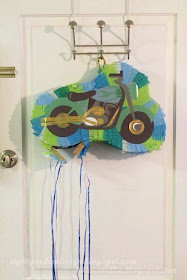Confession: I bought this Harmony House credenza a year and a half ago. I was so excited, too. It was covered in water rings, had damaged and missing veneer, was splattered with pink nail polish, and needed repair. It was only $9.99 at Value Village and I had a 20% off coupon, making it an
incredible steal. Even more incredible now that their furniture prices have gone up.
I was at the register paying for it while a guy was circling it in the furniture area. If I'd been five minutes slower, it would have gone to bidder number two. As it was, he jealously watched the salesperson put a "sold" tag on it and mentioned to me that it was a nice piece, but needed a drawer repair. "I know," I said, "thanks!" I recently spied
it's twin on eBay for $575, though in perfect condition.
My goal was to restore it to its former state and resell it, but the original legs were missing. I searched out new legs for it at BRING, found four that
almost matched for $1 apiece, and decided that they'd fit the bill. (I'd eventually need to cut off the brass capped ends to make the lengths match. It seriously pained me to do it, but couldn't be helped.)
I poked their threaded rod through a cardboard box to stand them up and start the stripping process.
The messed up drawers and top got stripped at the same time, first with green stripping gel, then with a sanding sponge.
The back of the top had lost its veneer, exposing the particle board (!!!) used for the top, so I ironed on and trimmed some new veneer along the back.
I also had to re-nail the masonite board to the back using little penny nails.
Finally, I started the staining process.
First coat.
The sides had too much damage to the veneer, and sanding too much more would have utterly destroyed it. I took a deep breath and decided to paint the sides and front frame with grey chalk paint.
Here's a nice angle of the freshly finished top.
This shows the stained veneer strip matching up decently to the rest of the edging, the re-nailed back, and the painted side.
Water-ring free top!
The brass hardware needed to be cleaned and refinished.
I don't recommend soaking in the salt/lemon juice mixture recommended on some blogs. All my brass plating sloughed off unevenly.
I used Rub n' Buff to recolor it until I can afford electroplating.
A little bit of sanding at the edges for texture, and some dark colored wax over the finish on the sides.
Finished, with legs reattached!
This is the first time I've refinished a piece this large, and I really like how it turned out. In the end, I moved it into my house rather than trying to resell it. I assume the painted sides, refinished hardware, and inexpert drawer repair make it less valuable (although certainly more attractive than the "before" photo).
Also, now that I
know the top is made of particle board, I wouldn't feel right listing it as simply "wood" as the owner of the $575 eBay version does. I mean, technically, that's correct, but I'd expect it to be a plank, not sawdust + glue covered with beautiful veneer. Apparently,
this is standard practice in the industry, but if I were the buyer, I'd be pretty surprised to make that kind of a discovery for nearly six-hundred dollars.
Counting the price for the credenza plus the legs, stain, stripper, and sanding sponges, I think I have about $50 into this piece. I think in its current condition I could probably sell it for more than that, but I'm going to hang onto it for awhile for storage. It looks kinda awesome in the spare room.
What do you think?
Thanks for reading!
p.s. you can make these photos larger by clicking on them! take a look at the first one, especially, to see the years of damage that had built up.
linking up to:
Junkin' Joe @Cottage Market
Creative Inspirations
Thrift-a-Saurus
Catch as Catch Can
The Vintage Farmhouse


































































